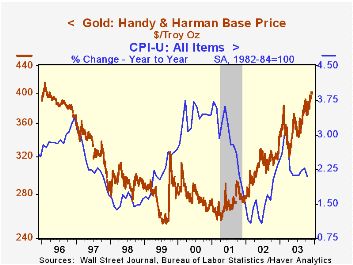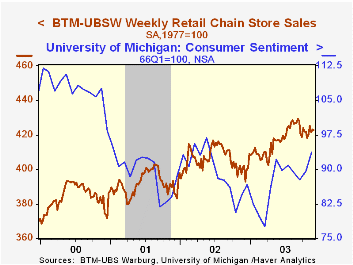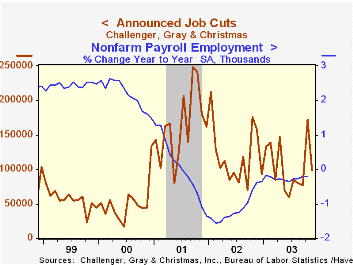 Global| Dec 02 2003
Global| Dec 02 2003Gold Prices Top $400/oz.
by:Tom Moeller
|in:Economy in Brief
Summary
Gold prices topped $400 per ounce yesterday for the first time since early 1996. The rise accompanied other indications of strength in pricing power including the rise in the November ISM price index. During the last twenty years [...]

Gold prices topped $400 per ounce yesterday for the first time since early 1996. The rise accompanied other indications of strength in pricing power including the rise in the November ISM price index.
During the last twenty years there has been a 41% correlation between the level of gold prices and the y/y change in the CPI.
Prices of metals generally have been strong as industrial activity has firmed. Stainless steel scrap prices have risen nearly 50% since yearend 2002 and copper prices have risen 37%. Aluminum prices also have risen 13%.
During the last twenty years there has been a 43% correlation between the y/y change in metals prices as measured by the Journal of Commerce/ECRI index and the change in factory sector industrial production.
| Commodity Prices | 12/01/03 | 12/31/02 | Y/Y | 2002 | 2001 | 2000 |
|---|---|---|---|---|---|---|
| Gold: Handy & Harman Base Price ($/oz.) | $400.25 | $344.80 | 26.5% | $310.05 | $271.06 | $278.88 |
| Stainless Steel Scrap ($/gross ton) | $1,159.00 | $782.00 | 57.0% | $717.10 | $650.52 | $739.07 |
| Copper: High Grade (COMEX, $/Lb.) | $0.96 | $0.70 | 26.3% | $0.72 | $0.73 | $0.84 |
by Tom Moeller December 2, 2003

Chain store sales fell 0.1% during the week that included Thanksgiving, according to the BTM-UBSW survey. Following the 1.2% gain in sales the opening week of November, weekly sales have been lackluster.
Sales during November with just one day left to tally were 0.5% ahead of October. That followed a 0.6% m/m October decline.
During the last five years there has been a 61% correlation between the year-to-year percent change in the BTM-UBSW measure of chain store sales and the change in non-auto retail sales less gasoline.
The BTM-UBSW retail chain-store sales index is constructed using the same-store sales reported by 78 stores of seven retailers: Dayton Hudson, Federated, Kmart, May, J.C. Penney, Sears and Wal-Mart.
Analysis from the Federal Reserve Bank of Richmond titled "Why Does Consumer Sentiment Predict Household Spending?" is available here.
| BTM-UBSW (SA, 1977=100) | 11/29/03 | 11/22/03 | Y/Y | 2002 | 2001 | 2000 |
|---|---|---|---|---|---|---|
| Total Weekly Retail Chain Store Sales | 422.8 | 423.3 | 5.2% | 3.6% | 2.1% | 3.4% |
by Tom Moeller December 2, 2003

Announced job cuts in November reversed much of the prior month's rise according to Challenger, Gray & Christmas. Job cut announcements fell 42.1% m/m after having more than doubled in October.
The three month moving average of job cut announcements nevertheless rose (-13.8% y/y) due to the October spike.
Job cut announcements eased m/m in the aerospace (-85.4% y/y), automotive (-44.2% y/y), chemical (-86.4% y/y), and financial (-90.9% y/y) industries. Announced layoffs in the electronics industry surged m/m although they were down 21.3% y/y.
Job cut announcements differ from layoffs in that many are achieved through attrition or just never occur.
During the last ten years there has been an 83% (inverse) correlation between the three month average level of announced job cuts and the y/y percent change payroll employment.
| Challenger, Gray & Christmas | Nov | Oct | Y/Y | 2002 | 2001 |
|---|---|---|---|---|---|
| Announced Job Cuts | 99,452 | 171,874 | -36.9% | 1,431,052 | 1,956,876 |
Tom Moeller
AuthorMore in Author Profile »Prior to joining Haver Analytics in 2000, Mr. Moeller worked as the Economist at Chancellor Capital Management from 1985 to 1999. There, he developed comprehensive economic forecasts and interpreted economic data for equity and fixed income portfolio managers. Also at Chancellor, Mr. Moeller worked as an equity analyst and was responsible for researching and rating companies in the economically sensitive automobile and housing industries for investment in Chancellor’s equity portfolio. Prior to joining Chancellor, Mr. Moeller was an Economist at Citibank from 1979 to 1984. He also analyzed pricing behavior in the metals industry for the Council on Wage and Price Stability in Washington, D.C. In 1999, Mr. Moeller received the award for most accurate forecast from the Forecasters' Club of New York. From 1990 to 1992 he was President of the New York Association for Business Economists. Mr. Moeller earned an M.B.A. in Finance from Fordham University, where he graduated in 1987. He holds a Bachelor of Arts in Economics from George Washington University.






